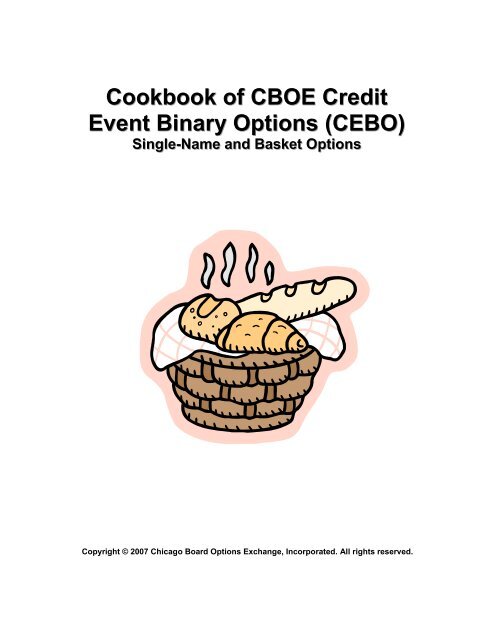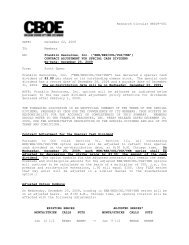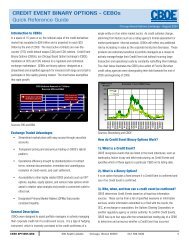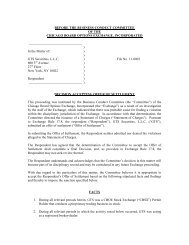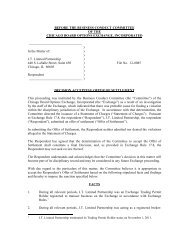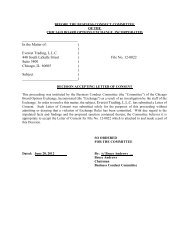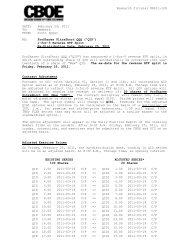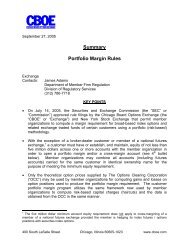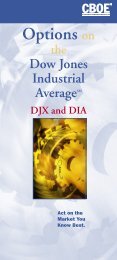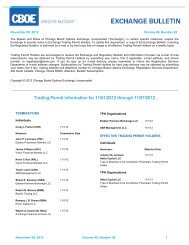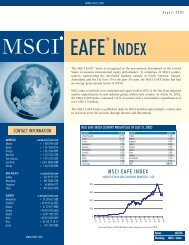Cookbook of CBOE Credit Event Binary Options (CEBO) - CBOE.com
Cookbook of CBOE Credit Event Binary Options (CEBO) - CBOE.com
Cookbook of CBOE Credit Event Binary Options (CEBO) - CBOE.com
You also want an ePaper? Increase the reach of your titles
YUMPU automatically turns print PDFs into web optimized ePapers that Google loves.
<strong>Cookbook</strong> <strong>of</strong> <strong>CBOE</strong> <strong>Credit</strong><br />
<strong>Event</strong> <strong>Binary</strong> <strong>Options</strong> (<strong>CEBO</strong>)<br />
Siinglle-Name and Basket Optiions<br />
Copyright © 2007 Chicago Board <strong>Options</strong> Exchange, Incorporated. All rights reserved.
<strong>Options</strong> involve risk and are not suitable for all investors. Prior to buying or<br />
selling an option, a person must receive a copy <strong>of</strong> Characteristics and Risks <strong>of</strong><br />
Standardized <strong>Options</strong> (ODD). Copies <strong>of</strong> the ODD are available from your broker,<br />
by calling 1-888-OPTIONS, or from The <strong>Options</strong> Clearing Corporation, One North<br />
Wacker Drive, Suite 500, Chicago, Illinois 60606 and at<br />
http://www.optionsclearing.<strong>com</strong>/. This manual has been developed by <strong>CBOE</strong> to<br />
serve as a guide to all users <strong>of</strong> <strong>Credit</strong> <strong>Event</strong> <strong>Binary</strong> <strong>Options</strong>. The requirements<br />
explained here are based on publication date rules and regulations, and<br />
therefore, subject to change. This manual should be used as a reference<br />
document and is not intended to be an all-en<strong>com</strong>passing restatement <strong>of</strong> <strong>CBOE</strong><br />
rules. No statement within this manual should be construed as a<br />
re<strong>com</strong>mendation to buy or sell a security or to provide investment advice.<br />
2
1. Introduction<br />
Table <strong>of</strong> Contents<br />
2. Description <strong>of</strong> <strong>CEBO</strong> Contracts<br />
a. Contract Design<br />
b. <strong>Credit</strong> <strong>Event</strong>s<br />
c. Succession and Redemption <strong>Event</strong>s<br />
d. Time Schedule <strong>of</strong> <strong>CEBO</strong>s<br />
e. Summary Table<br />
3. Price Quotation and Theoretical Pricing<br />
a. Quotation <strong>of</strong> <strong>CEBO</strong> Prices<br />
b. Theoretical Pricing<br />
c. Where to Find Probabilities <strong>of</strong> Default<br />
d. Where to Find Market Quotes for <strong>CEBO</strong>s<br />
4. Nuts and Bolts <strong>of</strong> Trading<br />
a. Capital Requirements<br />
b. Trading Fees<br />
c. Exercise and Settlement<br />
d. Symbology<br />
e. Membership Requirements<br />
f. Regulatory Status<br />
g. <strong>CEBO</strong> Systems Settings<br />
h. Position Limits<br />
5. Trading Applications<br />
6. Contact Information<br />
3
1. Introduction<br />
This guide seeks to provide the ingredients and recipes needed to trade <strong>Credit</strong><br />
<strong>Event</strong> <strong>Binary</strong> <strong>Options</strong> (<strong>CEBO</strong>) on a daily basis. It includes a detailed description<br />
<strong>of</strong> the products, pricing indicators, “nuts and bolts” facts useful for trading, trading<br />
applications, and background information on the credit market. For more<br />
detailed information, please refer to Chapter XXIX <strong>of</strong> the <strong>CBOE</strong> Rules.<br />
Before proceeding, what are <strong>CEBO</strong>s? Briefly, they are binary options that provide<br />
a hedge against <strong>Credit</strong> <strong>Event</strong>s such as a bankruptcy or a failure to pay debt<br />
obligations. In dollar terms, a <strong>CEBO</strong> pays a specified amount if a <strong>Credit</strong> <strong>Event</strong> is<br />
confirmed, and nothing otherwise.<br />
In a space <strong>of</strong> fifteen years or so, the notional exposure <strong>of</strong> the credit derivatives<br />
market has reached almost $34 trillion. This vibrant market has supplanted the<br />
traditional corporate bond market as the place to trade credit. The most active<br />
contracts are credit default swaps (CDS) and CDS indexes. <strong>CEBO</strong>s are <strong>CBOE</strong>’s<br />
translation <strong>of</strong> CDS and CDS indexes to an exchange environment that <strong>of</strong>fer<br />
familiar advantages to investors:<br />
• A streamlined market place with easy access through securities accounts,<br />
transparent pricing, and anonymous trading on the <strong>CBOE</strong> Hybrid Trading<br />
System.<br />
• The operational efficiency brought by standardization <strong>of</strong> contract terms,<br />
minimal documentation, immediate and unambiguous resolution <strong>of</strong> <strong>Credit</strong><br />
<strong>Event</strong>s, and automated settlement.<br />
• Negligible counter-party risk.<br />
• Clearing by the "AAA" Rated <strong>Options</strong> Clearing Corporation (OCC).<br />
There is another unique and significant advantage to trading credit options on<br />
<strong>CBOE</strong>. <strong>CBOE</strong> is also home to stocks, stock and index options, and volatility<br />
derivatives, including VIX options. These financial instruments all correlate well<br />
to credit, and their trading proximity and <strong>com</strong>mon clearing should simplify and<br />
reduce the costs <strong>of</strong> implementing hedging and arbitrage strategies based on<br />
these correlations.<br />
2. Description <strong>of</strong> <strong>CEBO</strong> Contracts<br />
<strong>CEBO</strong>s are binary options that pay a fixed dollar amount when <strong>CBOE</strong> confirms a<br />
<strong>Credit</strong> <strong>Event</strong> in the debt securities issued or guaranteed by some entity<br />
4
(“Reference Entity”). A <strong>Credit</strong> <strong>Event</strong> typically means that the issuer or guarantor<br />
has ceased to service its debt obligations and/or has filed for bankruptcy. Hence<br />
a <strong>CEBO</strong> can protect against the losses incurred by investors following a default.<br />
<strong>CBOE</strong> currently lists <strong>CEBO</strong>s referenced to single Reference Entities and<br />
launched Basket <strong>CEBO</strong>s, referenced to baskets <strong>of</strong> Reference Entities, on August<br />
28, 2007.<br />
a. Contract Design<br />
Single-Name <strong>CEBO</strong>s<br />
A single-name <strong>CEBO</strong> is referenced to the debt securities ("Reference<br />
Obligations" and “Other Relevant Obligations") issued or guaranteed by a<br />
Reference Entity. Its pay<strong>of</strong>f is binary. The option is automatically exercised and<br />
pays $100,000 if <strong>CBOE</strong> confirms that the Reference Entity had a <strong>Credit</strong> <strong>Event</strong><br />
between the listing date and the scheduled last day <strong>of</strong> trading <strong>of</strong> the option. It<br />
pays $0 if no <strong>Credit</strong> <strong>Event</strong> is confirmed to have happened during this period.<br />
Multiple-Payout Basket <strong>CEBO</strong>s<br />
A Multiple-Payout Basket <strong>CEBO</strong> is referenced to the debt securities <strong>of</strong> multiple<br />
Reference Entities. Examples are baskets referenced to the debt securities <strong>of</strong><br />
corporations in the same economic sector, or broad-based baskets referenced to<br />
the debt securities <strong>of</strong> corporations <strong>of</strong> the same credit quality. On the listing date,<br />
<strong>CBOE</strong> specifies the notional value <strong>of</strong> the basket, the <strong>com</strong>ponents <strong>of</strong> the basket,<br />
their basket weights and their estimated recovery rates. For example, a basket<br />
could have a notional value <strong>of</strong> $100,000, 10 equally weighted <strong>com</strong>ponents, each<br />
with a specified recovery rate <strong>of</strong> 40%.<br />
A Multiple-Payout Basket <strong>CEBO</strong> automatically pays a specified dollar amount<br />
each time that <strong>CBOE</strong> confirms a <strong>Credit</strong> <strong>Event</strong> in a <strong>com</strong>ponent <strong>of</strong> the basket. The<br />
basket <strong>com</strong>ponent is then removed from the basket and is not replaced. The<br />
<strong>Credit</strong> <strong>Event</strong> payout is equal to the notional value <strong>of</strong> the basket times the weight<br />
<strong>of</strong> the <strong>com</strong>ponent that has the <strong>Credit</strong> event times one minus its recovery rate.<br />
Using the same parameters as in the example above, the option would pay<br />
$6,000 (=$100,000 * .10 *(1-.4)) after each confirmed <strong>Credit</strong> <strong>Event</strong>. The sum <strong>of</strong><br />
payout(s) would range from $0 to $60,000 depending on how many <strong>Credit</strong><br />
<strong>Event</strong>s are confirmed by <strong>CBOE</strong> over the life <strong>of</strong> the Multiple-Payout <strong>CEBO</strong>.<br />
First-to-Default Basket <strong>CEBO</strong><br />
A First-to-Default Basket <strong>CEBO</strong>, also called “Single-Payout” <strong>CEBO</strong> basket, is<br />
similar to a Multiple-Payout Basket <strong>CEBO</strong>. The only difference is that the option<br />
5
can only be automatically exercised once, after the confirmation <strong>of</strong> the first <strong>Credit</strong><br />
<strong>Event</strong> in any basket <strong>com</strong>ponent. After this exercise, the option expires.<br />
Full contract specifications are posted at:<br />
http://www.cboe.<strong>com</strong>/Products/indexopts/credit_spec.aspx<br />
b. <strong>Credit</strong> <strong>Event</strong>s<br />
What is a <strong>Credit</strong> <strong>Event</strong>?<br />
<strong>CBOE</strong> can recognize bankruptcy, failure to pay 1 , debt restructuring and any other<br />
event <strong>of</strong> default specified in the terms <strong>of</strong> the relevant indenture as possible <strong>Credit</strong><br />
<strong>Event</strong>s. <strong>CBOE</strong> specifies which <strong>of</strong> these <strong>Credit</strong> <strong>Event</strong>s apply to a particular <strong>CEBO</strong><br />
on its listing date and this information is posted at :<br />
http://www.cboe.org/legal/crclReg_CREDIT.aspx<br />
Who Confirms <strong>Credit</strong> <strong>Event</strong>s?<br />
<strong>CBOE</strong> confirms the occurrence <strong>of</strong> <strong>Credit</strong> <strong>Event</strong>s.<br />
When and How Can <strong>Credit</strong> <strong>Event</strong>s be Confirmed?<br />
<strong>Credit</strong> <strong>Event</strong>s are determined based on at least two information sources. These<br />
sources can be public news services, regulatory agencies, other exchanges, the<br />
OCC or the courts. (The news services currently used by the Exchange are<br />
Bloomberg, Dow Jones News Services, the Wall Street Journal, the Financial<br />
Times or the New York Times). To be confirmed, a <strong>Credit</strong> <strong>Event</strong> must have<br />
occurred in the period extending from the listing time up to 10:59 pm Chicago<br />
time on the last day <strong>of</strong> trading (<strong>Credit</strong> <strong>Event</strong> confirmation period). <strong>CBOE</strong> has up<br />
to four business days after the scheduled last day <strong>of</strong> trading to determine and<br />
announce whether a <strong>Credit</strong> <strong>Event</strong> has occurred. Information announcing <strong>Credit</strong><br />
<strong>Event</strong>s will be posted on <strong>CBOE</strong>'s website under <strong>CBOE</strong>'s Contract Adjustments<br />
link: http://www.cboe.<strong>com</strong>/tradtool/contractscebo.aspx<br />
c. Succession and Redemption <strong>Event</strong>s<br />
Succession and Redemption <strong>Event</strong>s are two other types <strong>of</strong> events that can<br />
impact the trading and settlement <strong>of</strong> <strong>CEBO</strong>s. <strong>CBOE</strong> confirms the occurrence <strong>of</strong><br />
1 Failure to pay is defined as failure to pay the specified threshold amounts <strong>of</strong> interest and/or face value <strong>of</strong><br />
debt obligations after applicable grace periods have elapsed. The threshold amounts are described in<br />
contract specifications. This definition also applies to debt obligations whose payment has been<br />
accelerated by a material violation <strong>of</strong> the covenants governing the obligations .<br />
6
Succession and Redemption <strong>Event</strong>s. Information announcing these events will<br />
be posted on <strong>CBOE</strong>'s website under <strong>CBOE</strong>'s Contract Adjustments link:<br />
http://www.cboe.<strong>com</strong>/tradtool/contractscebo.aspx<br />
A Redemption <strong>Event</strong> occurs when all the debt securities <strong>of</strong> the <strong>CEBO</strong> Reference<br />
Entity are redeemed or mature. Since zero debt leaves little room for a <strong>Credit</strong><br />
<strong>Event</strong>, the expiration <strong>of</strong> a single-name <strong>CEBO</strong> is accelerated and it expires<br />
worthless.<br />
Redemptions <strong>of</strong> the debt <strong>of</strong> a <strong>com</strong>ponent <strong>of</strong> a <strong>CEBO</strong> Single-Payout or Multiple-<br />
Payout basket only result in the removal <strong>of</strong> that <strong>com</strong>ponent from the basket,<br />
however. The expiration <strong>of</strong> a <strong>CEBO</strong> Multiple-Payout basket is only accelerated<br />
after <strong>CBOE</strong> has confirmed a Redemption <strong>Event</strong> in every one <strong>of</strong> its <strong>com</strong>ponents.<br />
In a Succession <strong>Event</strong>, part <strong>of</strong> or all the debt <strong>of</strong> the Reference Entity <strong>of</strong> a <strong>CEBO</strong><br />
is transferred to other entities. This can occur following mergers, consolidations,<br />
spin-<strong>of</strong>fs and similar corporate actions. <strong>CBOE</strong> will look to the terms <strong>of</strong> the<br />
Reference Obligation(s) to determine what percentages <strong>of</strong> the debt if any have<br />
been transferred to other entities. These terms may be discussed in indentures,<br />
supplemental indentures as well as 8-K and other SEC filings <strong>of</strong> the Reference<br />
Entity that discuss material changes to the <strong>com</strong>pany. If, based on these terms,<br />
<strong>CBOE</strong> determines that a <strong>com</strong>pany has acquired more than 25% <strong>of</strong> the original<br />
debt, it is deemed to be a “Successor Reference Entity.” The original <strong>com</strong>pany<br />
can be one <strong>of</strong> the successors, but it does not have to be.<br />
In the case where a Reference Entity is taken private, the private <strong>com</strong>pany may<br />
be<strong>com</strong>e the Successor Reference Entity if it guarantees the debt. However, new<br />
<strong>Credit</strong> Default Option series listings referenced to the private Successor<br />
Reference Entity would not be listed.<br />
If <strong>CBOE</strong> confirms a Succession <strong>Event</strong> for an entity referenced by a Single-Name<br />
<strong>CEBO</strong>, <strong>CBOE</strong> will generally list a new Single-Name <strong>CEBO</strong> for each Successor<br />
Reference Entity. If <strong>CBOE</strong> were to confirm a <strong>Credit</strong> <strong>Event</strong> in any Successor, the<br />
corresponding option would automatically pay an appropriate fraction <strong>of</strong><br />
$100,000, e.g. $100,000 for a single successor, $50,000 for two successors, and<br />
$33,333 for three.<br />
If a Succession <strong>Event</strong> is confirmed for a <strong>com</strong>ponent <strong>of</strong> a Multiple-Payout or<br />
Single-Payout <strong>CEBO</strong> basket, <strong>CBOE</strong> will determine Successor Reference Entities<br />
to replace that <strong>com</strong>ponent in the <strong>CEBO</strong> basket. It will also specify weights and<br />
recovery rates for the Successor Reference Entities. These weights will add up to<br />
the weight <strong>of</strong> the original <strong>com</strong>ponent. The recovery rates <strong>of</strong> the Successor<br />
Reference Entities can differ from the recovery rate <strong>of</strong> the basket <strong>com</strong>ponent<br />
they replace. Hence the payouts may change.<br />
7
Example: Suppose that a Reference Entity referenced by a <strong>CEBO</strong> basket has a<br />
Succession <strong>Event</strong> and is replaced by two Successor Reference Entities. Also<br />
suppose that the notional amount <strong>of</strong> the basket is $100,000, that the weight <strong>of</strong><br />
the original Reference Entity is 10% and its recovery rate is 40%. Based on the<br />
terms <strong>of</strong> the succession, <strong>CBOE</strong> assigns a weight <strong>of</strong> 5% to each <strong>of</strong> the Successor<br />
Reference Entities and recovery rates <strong>of</strong> 40% and 45% to the first and second. If<br />
<strong>CBOE</strong> subsequently confirms a <strong>Credit</strong> <strong>Event</strong> in the first Successor Reference<br />
Entity, the option payout will be $3000 ($100,000 * .05 *(1 -.4)). And if a <strong>Credit</strong><br />
<strong>Event</strong> is confirmed in the second Successor Reference Entity, the payout will be<br />
$3,250. Had <strong>CBOE</strong> confirmed a <strong>Credit</strong> <strong>Event</strong> in the original Basket <strong>com</strong>ponent,<br />
the option payout would have been $6,000 ($100,000 * .1 * (1-.4)).<br />
Note that after a Succession <strong>Event</strong>, a Single-Payout <strong>CEBO</strong> basket still expires<br />
after the first <strong>Credit</strong> <strong>Event</strong> in any <strong>of</strong> the basket <strong>com</strong>ponents, which now include<br />
the Successor Reference Entities.<br />
d. Time Schedule <strong>of</strong> <strong>CEBO</strong>s<br />
<strong>CEBO</strong>s will be listed periodically with maturities ranging from one to 10.25 years.<br />
Expiration takes place four business days after the third Friday <strong>of</strong> the contract<br />
month when the options cease to trade. <strong>CBOE</strong> will continue to monitor <strong>Credit</strong><br />
<strong>Event</strong>s until 3:00 p.m. CT <strong>of</strong> the fourth business following the last day <strong>of</strong> trading.<br />
Recall that a <strong>Credit</strong> <strong>Event</strong> must occur between the listing date and 10:59 p.m. CT<br />
<strong>of</strong> the last day <strong>of</strong> trading.<br />
8
e. Summary Table <strong>of</strong> Different <strong>CEBO</strong>s<br />
<strong>Credit</strong> Option Single-Name <strong>CEBO</strong>s Multiple-Payout<br />
Basket <strong>CEBO</strong>s<br />
First-to-Default Basket <strong>CEBO</strong>s<br />
Underliers Debt securities <strong>of</strong><br />
Reference Entity<br />
Debt securities <strong>of</strong> multiple Reference Entities<br />
Notional Value $100,000 • Total basket notional value and <strong>com</strong>ponent weights are<br />
specified at listing date.<br />
• Component notional value = basket notional * <strong>com</strong>ponent<br />
weight.<br />
Recovery rates •<br />
Example: with 10 equally weighted <strong>com</strong>ponents and $100,000 total<br />
basket notional, each <strong>com</strong>ponent has a $10,000 notional value.<br />
Recovery rates are estimates <strong>of</strong> what can be recovered per dollar <strong>of</strong> debt after a <strong>Credit</strong><br />
<strong>Event</strong>. The credit option pays the residual, i.e. the loss per dollar.<br />
• The recovery rate <strong>of</strong> a single-name <strong>CEBO</strong> is always assumed to be 0.<br />
• Recovery rates <strong>of</strong> <strong>CEBO</strong> basket <strong>com</strong>ponents are specified at listing date <strong>of</strong> option.<br />
When does After a <strong>Credit</strong> <strong>Event</strong>. After any <strong>Credit</strong> <strong>Event</strong> After first <strong>Credit</strong> <strong>Event</strong> in any basket<br />
the option pay?<br />
in a basket<br />
<strong>com</strong>ponent.<br />
<strong>com</strong>ponent. After this, the option expires.<br />
What does it pay? $100,000<br />
After each <strong>Credit</strong><br />
<strong>Event</strong>:<br />
After first <strong>Credit</strong> <strong>Event</strong> only:<br />
Option Price<br />
Quotation and<br />
Effective Price<br />
Component notional value * (1-recovery rate).<br />
Example: If recovery rate is .4 and <strong>com</strong>ponent notional is $10,000,<br />
option pays $6,000= $10,000 * (1-.4)<br />
• Option price is quoted per $100 <strong>of</strong> total notional.<br />
• It is quoted in dollars and nickels, e.g. $35.25.<br />
• Effective price = quoted price * contract notional /100.<br />
Example: For single name <strong>CEBO</strong>, $35.25 quoted price corresponds to an effective price <strong>of</strong><br />
$35,250.<br />
<strong>Credit</strong> <strong>Event</strong> • Will include failure-to-pay, and may also include bankruptcy, debt restructuring, or any<br />
other event <strong>of</strong> default specified by the <strong>CBOE</strong>.<br />
• <strong>CBOE</strong> specifies qualifying <strong>Credit</strong> <strong>Event</strong>s at listing time.<br />
• <strong>CBOE</strong> confirms <strong>Credit</strong> <strong>Event</strong>s based on at least two sources drawn from a list <strong>of</strong><br />
specified newswire or information services, and/or information submitted to or filed with<br />
the courts, the SEC , an exchange or association, the <strong>Options</strong> Clearing corporation, or<br />
another regulatory agency or similar authority. The news services used by the Exchange<br />
are Bloomberg, Dow Jones News Services, the Wall Street Journal, the Financial Times<br />
and the New York Times.<br />
• <strong>CBOE</strong> can confirm <strong>Credit</strong> <strong>Event</strong>s up to four business days after last day <strong>of</strong> trading.<br />
Successions Successor weights are<br />
specified to determine<br />
payout after<br />
confirmation <strong>of</strong> <strong>Credit</strong><br />
<strong>Event</strong>s.<br />
Contract<br />
Maturities<br />
Last Day <strong>of</strong><br />
Trading<br />
• Successor weights and recovery rates are specified.<br />
• Successor weights add up to weight <strong>of</strong> the original Reference<br />
Entity. Successor Recovery rates can differ from the recovery<br />
rate <strong>of</strong> the original Reference Entity.<br />
Contracts expire from 1 to 10 ¼ years from listing date.<br />
The earlier <strong>of</strong> 3 rd Friday<br />
<strong>of</strong> contract month or<br />
date <strong>of</strong> <strong>Credit</strong> or<br />
Redemption <strong>Event</strong>.<br />
The earlier <strong>of</strong> 3 rd Friday<br />
<strong>of</strong> contract month or<br />
date on which <strong>Credit</strong> or<br />
Redemption <strong>Event</strong>s in<br />
all basket <strong>com</strong>ponents<br />
have been confirmed.<br />
9<br />
The earlier <strong>of</strong> 3 rd Friday <strong>of</strong> contract<br />
month or date <strong>of</strong> 1st <strong>Credit</strong> <strong>Event</strong> or<br />
date on which Redemption <strong>Event</strong>s in all<br />
basket <strong>com</strong>ponents have been<br />
confirmed.<br />
Expiration 4th business day after scheduled last day <strong>of</strong> trading or 2 business days after early last day <strong>of</strong><br />
trading.
3. Price Quotation and Theoretical Pricing<br />
a. Option Price Quotation<br />
A Single-Name <strong>CEBO</strong> pays $100,000 after a <strong>Credit</strong> <strong>Event</strong> is confirmed, but its<br />
price is quoted based on a $100 payout. Since the quoted price reflects the<br />
probability that a <strong>Credit</strong> <strong>Event</strong> will be confirmed times $100, it varies between $0<br />
and $100. <strong>CEBO</strong> prices are quoted in dollars and nickels, e.g. $34.05, $34.10.<br />
The effective price paid for the option is 1000 times the quoted price, based on a<br />
notional contract value <strong>of</strong> $100,000= 1000* $100. Thus if the quoted price is<br />
$34.05, the effective price is $34,050.<br />
The estimated quoted price <strong>of</strong> a <strong>CEBO</strong> based on Dana Corp. a <strong>com</strong>pany that<br />
went bankrupt in February 2006 is shown below next to the CDS spread <strong>of</strong><br />
DANA Corp. quoted by Bloomberg. As the bankruptcy approached, the DANA<br />
CDS spread rose to 3422 basis points, suggesting an estimated recovery rate <strong>of</strong><br />
approximately 65%. At this point, the price <strong>of</strong> a <strong>CEBO</strong> referenced to DANA<br />
should have theoretically reached $100, based on the assumed recovery rate <strong>of</strong><br />
0%.<br />
<strong>Credit</strong> Spread Basis Points<br />
3300<br />
2800<br />
2300<br />
1800<br />
1300<br />
800<br />
300<br />
Sources: Bloomberg and <strong>CBOE</strong><br />
Market Prices DANA CORP as <strong>of</strong> close 2/28/06<br />
CDS 5 Year Spread<br />
Estimated 5-Year<br />
CEDO Price<br />
9/1/2005<br />
9/13/2005<br />
9/21/2005<br />
9/29/2005<br />
10/11/2005<br />
10/19/2005<br />
10/27/2005<br />
11/8/2005<br />
11/17/2005<br />
11/29/2005<br />
12/7/2005<br />
12/15/2005<br />
12/23/2005<br />
1/4/2006<br />
1/12/2006<br />
1/23/2006<br />
1/31/2006<br />
2/8/2006<br />
2/16/2006<br />
2/27/2006<br />
10<br />
$100<br />
$90<br />
$80<br />
$70<br />
$60<br />
$50<br />
$40<br />
$30<br />
$20<br />
$10<br />
$-<br />
<strong>CEBO</strong> Estimated Price
. Theoretical Pricing<br />
The theoretical price <strong>of</strong> a single name <strong>CEBO</strong> is equal to the expected 2 value <strong>of</strong><br />
its payout discounted to the present by prevailing rates <strong>of</strong> interest. To illustrate,<br />
suppose that a Reference Entity can only have a <strong>Credit</strong> <strong>Event</strong> at a single date,<br />
e.g. five years from the current date. Also suppose that the risk-neutral<br />
probability <strong>of</strong> this event is 39.7%, and that the five- year discount factor is .7990.<br />
The theoretical price <strong>of</strong> the corresponding <strong>CEBO</strong> is equal to $31.72 = 100 * .397<br />
*.799.<br />
Generalizing to the case where a <strong>Credit</strong> <strong>Event</strong> can occur at any time until the last<br />
day <strong>of</strong> trading, theoretical price <strong>of</strong> the option is equal to 100 times the sum <strong>of</strong><br />
probabilities <strong>of</strong> default adjusted by the appropriate discount factors<br />
To simplify the calculation, the probability <strong>of</strong> default is assumed to be constant in<br />
sub-periods. Here is an illustration <strong>of</strong> this calculation for a 5-year <strong>CEBO</strong> :<br />
Term Structure <strong>of</strong> Default<br />
Probabilities<br />
Period<br />
11<br />
Period Default<br />
Probability p<br />
Discount<br />
Factor D<br />
100* p * D<br />
6 m 0.0156 0- 6m 0.0158 0.9758 1.5417<br />
1 yr 0.0311 6 m -1yr 0.0155 0.9530 1.4772<br />
2 yr 0.1034 1 - 2 yr 0.0723 0.9121 6.5942<br />
3 yr 0.2041 2 -3 yr 0.1007 0.8733 8.7940<br />
4 yr 0.3062 3 - 4 yr 0.1021 0.8352 8.5274<br />
5 yr 0.3970 4 - 5 yr 0.0908 0.7990 7.2550<br />
<strong>CEBO</strong> Price $ 34.19<br />
Source :<strong>CBOE</strong><br />
c. Where to Find Probabilities <strong>of</strong> Default<br />
Different services estimate probabilities <strong>of</strong> default. Some <strong>of</strong> the most popular are<br />
Bloomberg, Moody’s KMV, Reuters, and RiskMetrics Group. Probabilities <strong>of</strong><br />
default can be estimated from:<br />
• CDS prices<br />
• bond prices using Hull and White’s approach<br />
• equity prices using the Merton structural model or its variants<br />
• put option prices using either a structural model or a non-parametric<br />
algorithms<br />
• historical data<br />
2 The expectation is taken under the risk-neutral probability distribution.
• rating transition matrices calculated by rating agencies such as Moody’s KMV<br />
and Fitch, or<br />
• fundamental analysis <strong>of</strong> the reference entity.<br />
d. Where to Find Market Quotes for <strong>CEBO</strong>s<br />
Market quotes are available from data vendors and at <strong>CBOE</strong>'s website. For<br />
delayed quotes from <strong>CBOE</strong>'s website see:<br />
http://www.cboe.<strong>com</strong>/DelayedQuote/QuoteTable.aspx<br />
To get quotes, type the class, a space then the month/strike indicators, (e.g.,<br />
FDW IZ for the 2012 Ford 5-year <strong>Credit</strong> Default Option quotes).<br />
4. Nuts and Bolts <strong>of</strong> Trading<br />
a. Capital Requirements<br />
Single-Name <strong>CEBO</strong> Customer Margin Requirements<br />
Long customers: 100% <strong>of</strong> option price<br />
Qualified long customers: 20% <strong>of</strong> option price<br />
Short customers: Cash settlement amount<br />
Qualified short customers: Minimum (cash settlement amount, 20%<br />
<strong>of</strong> cash settlement amount plus option price)<br />
Basket <strong>CEBO</strong> Customer Margin Requirements<br />
Long customers: 100% <strong>of</strong> option price<br />
Qualified long customers: 15% <strong>of</strong> option price<br />
Short customers: Maximum possible cash settlement amount<br />
Qualified short customers: Minimum (maximum possible cash settlement<br />
amount, 15% <strong>of</strong> maximum cash settlement<br />
amount plus option price)<br />
• Margin deposits may consist <strong>of</strong> cash or marginable securities .<br />
• For additional information, refer to <strong>CBOE</strong> Rule 12.3(I).<br />
• Note that OCC does accept money market funds and treasury securities from<br />
clearing members to meet margin requirements. Please see OCC Rule 604 -<br />
Forms <strong>of</strong> Margin for more information on this:<br />
(http://theocc.<strong>com</strong>/publications/rules_bylaws_pdf/occ_rules.pdf)<br />
12
Market Maker Haircuts<br />
Haircuts for market makers will be determined by their clearing firms.<br />
For more details on the Margins and Net Capital Requirements for <strong>Credit</strong> Default<br />
<strong>Options</strong> please see http://www.cboe.org/legal/crclReg_CREDIT.aspx.<br />
b. Trading Fees<br />
See http://www.cboe.<strong>com</strong>/publish/feeschedule/<strong>CBOE</strong>FeeSchedule.pdf<br />
c. Exercise and Settlement<br />
If a <strong>Credit</strong> <strong>Event</strong> is confirmed prior to the scheduled expiration date, <strong>CEBO</strong>s will<br />
be automatically exercised two business days after the <strong>Credit</strong> <strong>Event</strong> confirmation<br />
date. If no <strong>Credit</strong> <strong>Event</strong> is confirmed prior to the last trading day, expiration will<br />
occur four business days after the last trading day. This lag provides a cushion <strong>of</strong><br />
time during which <strong>CBOE</strong> can continue to monitor for <strong>Credit</strong> <strong>Event</strong>s. Recall that, to<br />
be confirmed, the credit event has to occur in the period extending from the<br />
listing time to 10:59 p.m. (CT) on the last trading day.<br />
d. Symbology<br />
Quote and trade information will be disseminated by <strong>CBOE</strong> through the <strong>Options</strong><br />
Price Reporting Authority (OPRA), just like other options. Like other options,<br />
each <strong>CEBO</strong> product will have a unique class symbol, month and strike indicator.<br />
As illustrated below, <strong>CEBO</strong>S with the same underlying but different maturities will<br />
have unique class symbols.<br />
Equity<br />
Symbols/ Exp.<br />
Ticker Company Name<br />
Dates<br />
Sep-08 Sep-12<br />
GM General Motors Corp GCB GCY<br />
F Ford Motor Co FDE FDW<br />
HOV Hovnanian Enterprises Inc CKA CKJ<br />
SPF Standard-Pacific Corp JSV JSW<br />
For current lists <strong>of</strong> single name <strong>CEBO</strong>s and Basket <strong>CEBO</strong>s <strong>com</strong>ponents see:<br />
http://www.cboe.<strong>com</strong>/publish/OPIndexComp<strong>Credit</strong>Basket/Basket<strong>CEBO</strong>s.xls<br />
For the list <strong>of</strong> tickers used by different data vendors see:<br />
http://www.cboe.<strong>com</strong>/micro/credit/<strong>CEBO</strong>Symbols.pdf<br />
13
e. Membership Requirements<br />
For market making purposes, the seat costs assigned to each <strong>CEBO</strong> class will<br />
be determined by the formula applied to other options traded on <strong>CBOE</strong>.<br />
f. Regulatory Status<br />
<strong>CEBO</strong>s are SEC-regulated products. Rules can be found in Chapter XXIX <strong>of</strong><br />
<strong>CBOE</strong>’s rulebook at<br />
http://cchwallstreet.<strong>com</strong>/<strong>CBOE</strong>tools/PlatformViewer.asp?SelectedNode=chp_1_1<br />
&manual=/<strong>CBOE</strong>/rules/cboe-rules/<br />
g. <strong>CEBO</strong> Systems Settings<br />
For market making firms and firms that have written to the <strong>CBOE</strong>direct API and<br />
wish to place orders and/or stream quotes please see the following <strong>CBOE</strong> Reg<br />
Circular:<br />
http://www.cboe.org/legal/crclReg_CREDIT.aspx<br />
h. Position Limits<br />
5,000 contracts for a Single-Name <strong>CEBO</strong> class.<br />
50,000 contracts for Basket <strong>CEBO</strong>s<br />
5. Trading Applications<br />
Several possible trading applications <strong>of</strong> <strong>CEBO</strong>s and Basket <strong>CEBO</strong>s are outlined<br />
below purely for illustrative purposes. The Exchange is not re<strong>com</strong>mending or<br />
endorsing a particular investment strategy or providing investment advice, and<br />
encourages investors to consult with their broker.<br />
Single-Name <strong>CEBO</strong>s can be used for various investment strategies, including but<br />
not limited to:<br />
14
• Hedge or take a position on the credit risk <strong>of</strong> U.S. corporate debt. Since<br />
single-name <strong>CEBO</strong>s pay a fixed dollar amount following a <strong>Credit</strong> <strong>Event</strong>,<br />
investors can buy <strong>CEBO</strong>s to convert corporate debt to Treasury quality<br />
without having to sell this debt in a highly illiquid market. Conversely, <strong>CEBO</strong><br />
sellers can take on credit risk without having to buy corporate bonds and also<br />
without having to make an investment at the risk-free rate. This is a useful<br />
feature which can be implemented by overlaying <strong>CEBO</strong>s over fixed in<strong>com</strong>e<br />
portfolios or for capital structure arbitrage or convertible bond arbitrage.<br />
• Hedge assets with correlated prices. As illustrated below for Dana Corp.<br />
when credit quality deteriorates and the credit spread widens, the share price<br />
usually falls to zero and the volatility <strong>of</strong> put options tends to increase.<br />
Temporary dislocations between credit, volatility and equity markets can arise<br />
due to market specific imbalances or other “technical factors.”<br />
Implied Volatility<br />
350<br />
300<br />
250<br />
200<br />
150<br />
100<br />
50<br />
0<br />
09/01/05<br />
09/15/05<br />
09/29/05<br />
Sources: Bloomberg and <strong>CBOE</strong><br />
DANA CORP up to close 2/28/06<br />
1 Month ATM Implied Volatility<br />
Estimated <strong>CEBO</strong> Price<br />
Share Price<br />
10/13/05<br />
10/27/05<br />
11/10/05<br />
11/24/05<br />
12/08/05<br />
o Fixed-recovery CDS spreads should have a close relation to <strong>CEBO</strong><br />
prices because the differences between the two are primarily limited to<br />
the amortization <strong>of</strong> the option premium and suspension <strong>of</strong> the coupon<br />
payment after a <strong>Credit</strong> <strong>Event</strong>.<br />
o A generic CDS is a little different. It is generally a double play on<br />
default and the recovery rate. This difference will generally mostly<br />
15<br />
12/22/05<br />
01/05/06<br />
01/19/06<br />
02/02/06<br />
02/16/06<br />
$100<br />
$90<br />
$80<br />
$70<br />
$60<br />
$50<br />
$40<br />
$30<br />
$20<br />
$10<br />
$-<br />
<strong>CEBO</strong> Price and Share Price
matter close to a <strong>Credit</strong> <strong>Event</strong> because recovery rates typically do not<br />
drive CDS spreads before then.<br />
o <strong>Credit</strong> traders can arbitrage the basis between the implied spreads in<br />
<strong>CEBO</strong> prices and the spreads <strong>of</strong> credit asset swaps in the same way<br />
that they arbitrage the basis between CDS and credit asset swaps.<br />
• Adjust the <strong>com</strong>position <strong>of</strong> a long or short exposure to a CDS index or<br />
synthetic CDO.<br />
Basket <strong>CEBO</strong>s can be used for various investment strategies, including but not<br />
limited to:<br />
• Hedge credit exposures to economic sectors, credit quality sectors or a crosssection<br />
<strong>of</strong> the market.<br />
• Adjust the sector or quality pr<strong>of</strong>ile <strong>of</strong> a broad-based CDS index.<br />
• Hedge the sector or market <strong>com</strong>ponent <strong>of</strong> the credit risk in a single name<br />
credit exposure.<br />
• Hedge volatility exposures. The correlations between credit spreads, stock<br />
prices, and volatility typically rise during a financial crisis. This indicates that<br />
a long position in a broad-based <strong>CEBO</strong> basket provides a hedge against the<br />
extreme volatilities that prevail when worst-case scenarios materialize. Even<br />
at low to moderate volatilities, VIX tracks speculative grade credit spreads.<br />
<strong>Credit</strong> Spreads<br />
1000<br />
800<br />
600<br />
400<br />
200<br />
0<br />
VIX vs <strong>Credit</strong> Spreads since 2003<br />
1/10/03 1/10/04 1/10/05 1/10/06 1/10/07<br />
Sources: Standard and Poor’s and <strong>CBOE</strong><br />
S&P Speculative Grade <strong>Credit</strong> Spread<br />
S&P Investment Grade <strong>Credit</strong> Spread<br />
VIX<br />
16<br />
40<br />
35<br />
30<br />
25<br />
20<br />
15<br />
10<br />
5<br />
0<br />
VIX
7. Contact Information<br />
John Angelos D Dangelos@cboe.<strong>com</strong><br />
<strong>CBOE</strong>®, Chicago Board <strong>Options</strong> Exchange®, CFE®, <strong>CBOE</strong> Volatility Index® and VIX® are<br />
registered trademarks <strong>of</strong> <strong>CBOE</strong>. <strong>CEBO</strong> and <strong>CEBO</strong> Baskets are trademarks or servicemarks <strong>of</strong><br />
<strong>CBOE</strong>. Other names, logos, designs, titles, words or phrases in this publication may constitute<br />
trademarks, service marks, or trade names <strong>of</strong> Chicago Board <strong>Options</strong> Exchange, Incorporated or<br />
other entities and which may be registered in certain jurisdictions.<br />
<strong>Options</strong> involve risk and are not suitable for all investors. Prior to buying or selling an option, a<br />
person must receive a copy <strong>of</strong> Characteristics and Risks <strong>of</strong> Standardized <strong>Options</strong> (ODD). Copies<br />
<strong>of</strong> the ODD are available from your broker, by calling 1-888-OPTIONS, or from The <strong>Options</strong><br />
Clearing Corporation, One North Wacker Drive, Suite 500, Chicago, Illinois 60606 and at<br />
http://www.optionsclearing.<strong>com</strong>/. This manual has been developed by <strong>CBOE</strong> to serve as a guide<br />
to all users <strong>of</strong> <strong>Credit</strong> <strong>Event</strong> <strong>Binary</strong> <strong>Options</strong>. The requirements explained here are based on<br />
publication date rules and regulations, and therefore, subject to change. This manual should be<br />
used as a reference document and is not intended to be an all-en<strong>com</strong>passing restatement <strong>of</strong><br />
<strong>CBOE</strong> rules. No statement within this manual should be construed as a re<strong>com</strong>mendation to buy<br />
or sell a security or to provide investment advice.<br />
17


